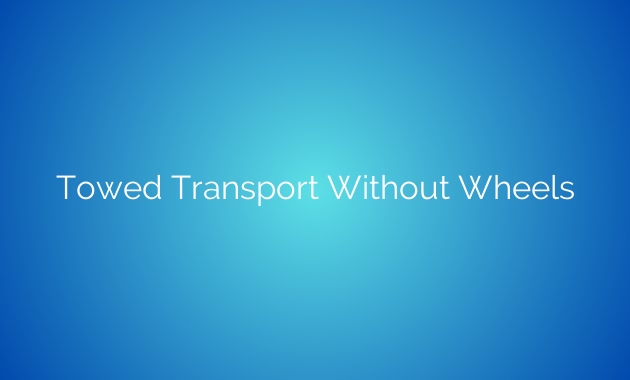Contents
Towed Transport Without Wheels
Transporting vehicles has become an essential part of our modern society, whether it’s moving Cars across long distances or relocating them locally. However, traditional methods of towing often require the use of wheels, which might not always be feasible or practical in certain situations. This article explores the concept of towed transport without wheels, presenting alternative methods and technologies that are revolutionizing the transportation industry.
1. Tow Dollies
Tow dollies are specialized devices designed to haul vehicles without the need for their own wheels. These dollies feature a bed or platform that supports the front or rear wheels of the towed vehicle, allowing it to be transported safely. The dollies themselves are equipped with wheels and a hitch, enabling them to be towed by a separate vehicle.
Using a tow dolly provides several advantages, such as increased maneuverability and reduced wear and tear on the towed vehicle. Additionally, it allows for the transportation of vehicles that are unable to move under their own power, making it an ideal solution for disabled or non-operational cars.
2. Flatbed Trailers
Flatbed trailers offer another effective method for towing vehicles without wheels. These trailers consist of a large, flat platform that can accommodate a wide range of vehicles, regardless of their condition or drivability. The towed vehicle is secured onto the flatbed using straps or chains, ensuring stability during transportation.
This method is particularly useful for transporting oversized or heavy vehicles, as well as multiple vehicles simultaneously. The flatbed design eliminates the need for dollies or specialized equipment, simplifying the towing process and reducing costs.
3. Tilt Trays
Tilt trays, also known as rollback or slide bed trucks, are another innovative solution for towing vehicles without wheels. These trucks feature a hydraulic tilting mechanism that allows the entire flatbed to be tilted backward, creating a gentle slope. The towed vehicle is then winched onto the tilted bed and secured in place, ready for transportation.
Tilt trays are widely used for various purposes, including the transportation of damaged vehicles, machinery, and even shipping containers. This method ensures optimal safety and efficiency while minimizing the risk of further damage to the towed vehicle.
4. Tow Bars
Tow bars provide a straightforward and economical option for towing vehicles without wheels. These devices consist of a set of bars or rods that connect the towed vehicle to the towing vehicle. The towed vehicle is lifted at its front or rear end and secured in place using straps or chains.
Tow bars are commonly used to transport smaller vehicles, such as motorcycles or compact cars, as they offer ease of installation and increased maneuverability. However, they may not be suitable for larger or heavier vehicles due to potential stability issues.
5. Advanced Technologies
Advancements in technology have led to the development of even more sophisticated methods for towing vehicles without wheels. For instance, the use of hydraulic lift systems and remote-controlled platforms allows for precise and efficient loading and unloading of vehicles, eliminating the need for manual labor and reducing the risk of damage.

Additionally, self-driving or autonomous towing vehicles are being tested and implemented in certain contexts, providing a fully automated solution for towing vehicles without wheels. These vehicles utilize advanced sensors, algorithms, and artificial intelligence to safely and efficiently transport vehicles from one location to another.
Conclusion
Towed transport without wheels has evolved significantly, offering various alternatives to traditional towing methods. Whether it’s using tow dollies, flatbed trailers, tilt trays, tow bars, or leveraging advanced technologies, there is a solution for every towing need. These innovative approaches provide enhanced safety, flexibility, and efficiency, catering to a wide range of vehicles and circumstances.
Frequently Asked Questions about Towed Transport Without Wheels
1. Can I tow a vehicle without wheels?
Yes, you can tow a vehicle without wheels using methods such as tow dollies, flatbed trailers, tilt trays, or tow bars.
2. How much does it cost to tow a vehicle without wheels?
The cost of towing a vehicle without wheels can vary depending on factors such as the distance, towing method, and additional services required. It is best to contact towing companies for accurate pricing information.
3. Is towing a vehicle without wheels safe?
When done correctly and using appropriate equipment, towing a vehicle without wheels can be safe. It is essential to follow the recommended procedures and ensure the towed vehicle is properly secured.
4. Can any vehicle be towed without wheels?
Most vehicles can be towed without wheels, regardless of their condition or drivability. However, it is recommended to consult towing professionals to assess the specific requirements and feasibility for each vehicle.
5. Are there any legal restrictions on towing vehicles without wheels?
Legal restrictions regarding towing vehicles without wheels may vary depending on your location. It is advisable to familiarize yourself with local regulations and obtain the necessary permits or approvals before proceeding with towed transport.
